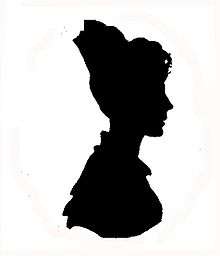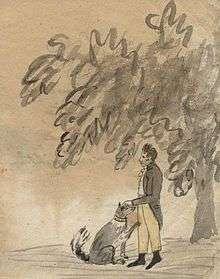Elizabeth Bridget Pigot
| Elizabeth Bridget Pigot | |
|---|---|
 A contemporary silhouette | |
| Born |
1783 St Werburgh's parish in Derby |
| Died | 1866 |
| Education | at home |
| Parent(s) | John Hollis and Margaret Pigot |
Elizabeth Bridget Pigot (1783–1866) was a correspondent, friend and biographic source for Lord Byron.
Biography
Pigot was born on 20 September 1783 in St Werburgh's parish in Derby to Dr John Hollis Pigot and his wife Margaret (born Becher). Elizabeth's father, John, was a physician and one of the founders of Derby Philosophical Society with Erasmus Darwin and William Strutt.[1] Pigot's father was to die when he was 36.[2]
In 1804 she was 21 and she met the sixteen-year-old Byron who had moved opposite them in April.[3] They became friends and she would accompany his singing on the piano. Pigot and Byron corresponded with each other until 1811. During this time Byron was at Trinity College, Cambridge whereas Pigot appears to have received her education at home or at a nearby girls' school. Pigot would copy out the poems that Byron sent her. Some of Byron's early encouragement with his poetry came from Pigot. In 1806 and 1807 Elizabeth and her brother John, who was also a friend of Byron, helped to expedite the publication of three of Byron's poetic works through a publisher in Newark.

In 1807 Pigot became engaged briefly to an officer in India[3] but this never led to marriage but it did result in Byron writing a poem dedicated to Pigot. In the same year, Pigot used her water colours to create a short poetical story that featured Byron called "The Wonderful History of Lord Byron and his Dog" which she illustrated with sketches of Byron and his dog. The work is thought to be a parody of Mrs Hubbard and her dog. There appears to be little evidence for a romantic connection between Pigot and Byron but she did keep locks of his hair. It was reported in the first issue of the Dictionary of National Biography that Pigot's engagement was broken off as a result of writing letters to her fiancee and to Byron and then placing the letters in the wrong envelopes.[4] However this story is not included in the latest version.[5]
Pigot also created a painting of Byron's eye which has led some to speculate that Pigot's feelings may not have been entirely platonic.[5] She was upset when Byron's former mistress visited from Italy and failed to call upon her. Pigot documented Byron's life and six years after the Countess Guiccioli sent her a lock of her hair which Pigot placed with a similar cutting from Byron.
In 1828 she was discovered by the first of Byron's biographers, Thomas Moore. Pigot was able to supply him with a great deal of material. Pigot started a correspondence with John Murray of the publishing family who was involved with Byron's publishings and his biography. It was Moore and the publisher John Murray who burnt Byron's papers to prevent further scandal. She was to eventually receive engravings from his son, also John Murray, in thanks for her assistance. In the same year she managed to catch a glance of Byron's daughter Ada Lovelace which pleased her.[3]
References
- ↑ R.P. Sturges. "The membership of Derby Philosophical Society" (PDF). Midland history. Birmingham University. pp. 215–223. Retrieved 2009-01-01.
- ↑ Obituaries, Gentleman's magazine, accessed September 2011
- 1 2 3 Ivan Pregnolato, ‘Elizabeth Bridgot Pigot, Byron's female friend', The Nottingham Byron Web Archive: Byron and the Pigots, ed. Matthew Green (University of Nottingham, 2008): http://byron.nottingham.ac.uk/archive.
- ↑

- 1 2 Annette Peach, ‘Pigot, Elizabeth Bridget (1783–1866)', Oxford Dictionary of National Biography, Oxford University Press, 2004 accessed 10 Sept 2011